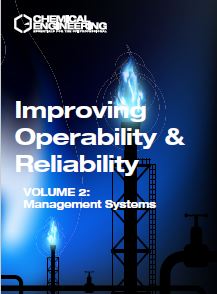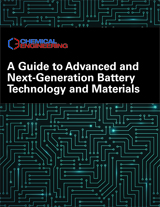Description
The key to ensuring optimal plant reliability in chemical process industries (CPI) facilities is to have proper management strategies in place, to ensure safe, appropriate day-to-day activities.
This Guidebook shares a wealth of engineering recommendations and best practices to ensure that plant-wide and process-specific systems operate reliably and trouble-free. Content in this volume focuses on winning maintenance strategies, reducing fire and explosion risk, addressing cybersecurity challenges and optimizing sealing systems.
Several engineering articles provide guidance on designing strong, user-friendly control systems and selecting proper instrumentation for measuring pressure, temperature and level.
Delivered in a PDF format, 213 pages.
Articles Include:
Static Electricity Discharge and Fire Prevention
Chemical Protective Clothing
Chemical Lifecycle Management
Sustainability demands a higher level of oversight that seeks new ways to effectively and cost efficiently procure, handle and dispose of, or recycle materials
Extremely Low-Temperature Systems
Understanding the nuances of low-temperature engineering is key to safe and efficient operations
New Measurement Practices for Cold Climates
Selecting the right pressure, temperature, flow and level meters and connection systems can help to eliminate the need for heated enclosures and sensing lines
Control Engineering for Chemical Engineers
Chemical engineers who are aware of process control requirements and challenges are in a position to improve process designs
Cooling Towers: Estimate Evaporation Loss and Makeup Water Requirements
Applying mass and energy balance calculations yields critical operating insight
CPI Machinery: Commissioning, Startup and Piping
Practical notes on installation, piping, support, layout, nozzle-loads, stress analysis, precommissioning, commissioning, startup and operation of rotating machinery
Flare Consolidation Considerations
Consolidating multiple flares can help mitigate emissions and maintenance
The Relationship Between Materials Selection and Machining Processes
An awareness of the impact of materials selection on the machining processes for small, complex components can affect overall end-product quality and costs
Computerized Maintenance Management Systems For Effective Plant Performance
Corralling gigabytes of predictive maintenance data isn’t easy, but it’s essential for streamlining your process
Get the Most out of Vibration Analysis
By listening to the messages your components are sending, you will be better able to assess the status of your machinery and take action to address problems
Remote Thermal Sensing
By making it easy to detect heat anomalies, thermal cameras and infrared thermometers support preventive and predictive maintenance
Controlling Acoustic Coupling
Furnace pulsation is a problem caused by the coupling between heat release from a burner and acoustic waves of the hosting heater. Enhancing natural damping of the heater is a practical and attractive solution
Project Optimization Through Engineering
Follow these practical recommendations to reduce capital outlay and operating costs, deliver shorter schedules and improve design quality
The Integral Role of Waste Management in Capital Projects
To avoid unnecessary efforts and mitigate risks, all phases throughout the design and implementation of large capital projects should incorporate comprehensive planning for waste management
Dynamic Modeling for Steam System Control
Dynamic modeling fills in the gaps of steady-state modeling and provides a more complete, reliable and efficient analysis
INDUSTRIAL CONTROL SYSTEMS SECURITY: The Owner-Operator’s Challenge
Addressing the cybersecurity of industrial control systems requires a collaborative response, beginning with a realistic assessment
Materials Selection In The CPI
An overview of the many factors to be considered when selecting materials of construction
Advances in Process Temperature Measurement: Trends and Technologies
Process temperature measurement is a constantly evolving field, and new technologies have allowed for more reliable measurements to be realized in many applications
Measuring Exposures to Aerosols and Dust
Accurate measurements of exposures to aerosols and dusts by plant personnel can be tricky. Here is some help for determining exposures and addressing uncertainties
Rapid Prediction of Prandtl Number of Compressed Air
Two methods are presented and compared for quickly calculating this important, yet neglected parameter
Determining Friction Factors in Turbulent Pipe Flow
Several approaches are reviewed for calculating fluid-flow friction factors in fluid mechanics problems using the Colebrook equation
Optimal Cooling Systems For Coastal Plants
When all economic and environmental factors are considered, a cooling tower may be the best option
A Method for Quantifying Pipe Vibrations
A technique to quantify vibration forces can help prevent pipe failures due to vibration-induced fatigue
Fired Heaters: Best Practices for the Control of Fuel Gas
Adopt these practices to ensure new project success, and to achieve safe control and reliable, efficient operation going forward
Managing Large Chemical Plant Startups
Prudent planning and scheduling during a project’s front end can lead to more expedient commissioning and startup activities
Connecting Operations Personnel to Reliability Efforts
Seven methodologies are described to help operations staff take greater ownership of asset performance
Implementing an ‘Integrity Operating Window’ Program
An effective Integrity Operating Window (IOW) program — which establishes safe operating limits and acceptable limits of process variation before an asset begins to degrade — can help operators stay ahead of potential repairs and reduce risk
Rethinking Maintenance: Transitioning to a Proactive Approach
Deploying well-timed audits and properly training employees are among the steps companies can take to realize maintenance strategies that are proactive rather than reactive
Condition-Based Maintenance Management Enhances Reliability
Understand reliability, condition monitoring and maintenance management to keep rotating equipment in top form
Burner Inspection and Maintenance
Burners and their components can be quite complex. Establishing maintenance and inspection best practices encourages longterm operational reliability
Critical Connections Demand Certainty
Understanding bolts’ behavior during routine tightening procedures helps to ensure leak-free, reliable operations
Optimizing Flare Operation Through Proper Design
Flare problems are often caused by the seal systems that are designed to control air ingress. Follow these troubleshooting guidelines to improve design and ensure safe, reliable flare operation
Improving the Operability of Process Plants
Turndown and rangeability have a big impact on the flexibility and efficiency of chemical process operations
Calculate NPSH with Confidence
Determining net positive suction head (NPSH) can be confusing, but with these guidelines, engineers can avoid the pitfalls of incorrect calculations
Tolerable Risk
While determined risk is generally well understood, tolerable risk can be the missing link to complete risk assessments
Applying CPI Temperature Sensors
Don’t fall back on outdated rules of thumb that may no longer be valid, or ‘plug and play’ solutions that may not be applicable
Specifying Elastomer Seals for Plastic Piping
Careful attention to elastomer properties and variation by manufacturer can help optimize specification




